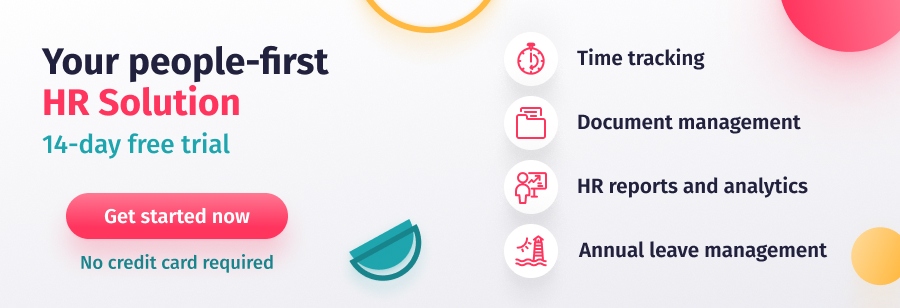Your people are your company’s most valuable asset, which is why talent management is so important. It covers everything to do with… well…talent.
Effective talent processes can result in increased productivity, reduced turnover and stronger business performance and competitiveness. But, when mismanaged, companies might experience low staff retention and poor performance, both of which can cause irreparable damage to the employer’s reputation.
In this article, we’ll guide you through how to develop a comprehensive talent management strategy and the impact this can have on your company’s success.
What is Talent Management?
Talent management covers everything from candidate attraction to development, retention and offboarding. It ensures all of the employees in your organisation progress, succeed and drive your business objectives.
To get it right, companies must find the balance between identifying critical competencies needed to achieve business goals and developing strategies to acquire and develop those skills within their workforce. Doing so requires a strategy that touches upon each stage of the employee life-cycle, including:
- Recruitment and hiring
- Performance management
- Learning and development
- Succession planning
- Employee engagement.
The goal? To make sure your business has the right people with the right skills in the right positions to achieve its objectives.

The Benefits of Effective Talent Management
Performance and Productivity
Talent management strategies such as performance management, coaching and mentoring all contribute to the employee experience whilst developing their skills. When teams have a positive experience at work and feel a sense of purpose and meaning, it also has a positive effect on productivity. Research has proven that happy employees are 12% more productive and engaged employees are 50% more likely to exceed performance targets. Happy, engaged individuals equal productive, high-performing teams.
Diversity, Equity and Inclusion
Diversity, equity and inclusion go hand in hand with talent management. A study found 70% of companies that rated themselves as “world-class” in relation to talent programmes placed gender issues and global diversity as a priority. Those that rated their programmes less highly only saw 43% planning to concentrate on gender issues and 61% on diversity.
First and foremost, D&I has become fundamental to job seekers, who are even willing to pursue jobs with lower salaries to work in businesses they see as more diverse. The fact that employee review site Glassdoor now allows people to rate their satisfaction with DE&I at their companies highlights how crucial a role it plays in jobseekers’ decision-making.
But the benefits extend further than talent attraction. Diversity increases employee learning, creativity, sense of belonging and pride in work, all of which contribute to positive business results. According to Gartner, companies that focus on D&I have as much as 1.4x more revenue per employee and are 120% more capable of meeting financial targets.
Culture
It’s chicken-or-egg with culture and talent management; the two consistently impact and shape each other. Culture shapes employee behaviour, employee behaviour also shapes culture.
Company culture also plays a role in shaping how an organisation is perceived from the outside – the employer brand – which can help to attract and retain top talent. The building blocks of a strong culture are very similar to that of talent management:
- Opportunities for learning and development.
- Recognising and rewarding high performance.
- Creating a positive work environment.
Employee Engagement
When you invest in talent management, you ensure onboarding, learning, development and progression processes are strengthened and streamlined. You are showing your employees that you value them and hold them at the centre of your organisation, which is the precursor to engaged teams.
According to Accenture, this can only strengthen your bottom line. Businesses with highly engaged workforces have 21% higher profits than those with poor engagement. Plus, companies that fall into the top 20% of engagement scores experience 41% less absenteeism and 59% lower turnover.
Data
Often, data is the driver of key business decisions, and a top talent management strategy will supply you with plenty! Key performance indicators will help you track your efforts and report on progress. This will allow you to make evidence-based decisions as you move forward with your strategy, building on successes and improving where necessary.
HR software can help you manage your data and generate more insightful reports to monitor the progress of your talent management strategy against your business’s goals and objectives.
Key Steps to Developing a Talent Management Strategy
1) Define your organisation’s goals and objectives
Start with your business strategy. Your talent management strategy should always align with your overall business goals and objectives. Ascertain what your company needs to achieve its goals and the barriers to getting there. Then consider the people and skills you need to help realise them.
2) Assess your current talent
What are the gaps in your current workforce, and are they critical to your success? This is also the time to evaluate career paths and development opportunities, take stock of high performers, and look for employees with skills, competencies and the potential to succeed. The 9-box grid is an effective tool for doing so.
3) Identify critical positions
Think about the skills and competencies you need to achieve the goals of the business. These should form the basis of the job positions that you create.
4) Start succession planning
Once you’ve identified and filled your critical positions, you need a plan for when an employee either progresses internally or leaves the business. Think about which roles your current talent pool could move to in the future and ensure they have the training and development opportunities they need available to them.
This process will be much easier if you have been continuously cross-training your teams. Businesses are left in the lurch all too often when an employee moves on and takes their undocumented knowledge with them!
5) Develop a recruitment strategy
The importance of a strong talent attraction shouldn’t be overlooked! Hire well and you’ll build a strong workforce which will make internal talent management processes easier down the line.
A recruitment strategy is a lot more than salaries and job ads. It’s built on five key pillars which each require attention and planning:
- Workforce Planning
- Employer Branding
- Sourcing Candidates
- Interviewing
- Onboarding
Treating your existing employees well can go a long way in attracting talent, too. Consider implementing an employee value proposition and shouting about it at every stage of your recruitment pipeline. This is a way of standing out from competitors and incentivising top talent to join your business.
6) Implement a performance management system
Once you’ve built the right team and provided them with the relevant tools and training, you’ll need to monitor their progress and performance to ensure you’re getting the best out of each individual.
A performance management system aligns the broader organisational goals with the objectives of employees, allowing you to boost business growth whilst supporting employee performance and productivity. This should involve 360-degree feedback, performance appraisals and performance improvement plans. If you would prefer to carry out a competency-based evaluation, consider using the 9-box grid which evaluates an employee’s current productivity and future potential.
However you choose to do so, tracking performance will allow you to identify underperformers and create action plans for talent development.

7) Focus on training and development
Make sure training programmes are readily available and accessible to all employees. Offering development initiatives will empower your employees to develop the skills and knowledge they need to perform their current roles and prepare them for future roles. L&D initiatives have also been proven to create high-performing workplaces that generate greater ROI. A Gallup report revealed that companies investing in training schemes see 11% greater profitability and are twice as likely to retain their employees.
8) Foster a high-performance culture
This step is about communicating and reinforcing values and positive behaviours. Of course, highlighting overarching goals and objectives is important, but it’s not the only way to boost performance. You also need to encourage soft skills such as collaboration, agility, open-mindedness, creativity and purpose-driven work. These are just as integral to employee productivity!
9) Continuously monitor and evaluate
To ensure your talent management strategy remains effective, you must keep adapting and improving your plan. Being agile will allow you to react faster if business priorities, recruitment trends or other external factors change.
How Can Factorial Help You Execute Your Talent Management Strategy?
Factorial’s talent management solution is formed of four key components to help you effectively execute, monitor and evaluate your strategy.
Applicant Tracking System
With Factorial, you can create a fully customisable career page that showcases your employer brand. You can manage candidates through the hiring process and automate your communications so that even unsuccessful candidates receive a response.
Employee Onboarding and Offboarding
Factorial’s onboarding tool ensures new hires are integrated efficiently and hit the ground running. Plus, any personal information gathered through the ATS is saved and carried across into onboarding to avoid extra admin. The platform also streamlines offboarding by customising workflows and assigning tasks to all employees involved in the departure!
Performance Management
Our performance management tool gives you insight into every level of your workforce so you can support employee development and make more informed decisions about your team. You can even automate the entire performance review process to make feedback and improvement plans less time-consuming.
Measure and Align Company and Employee Goals
Factorial’s insights tool empowers you to measure company and employee objectives using OKR methodology. This way, you can ensure your talent management strategy aligns with your business goals. It also allows you to track key metrics to monitor performance and productivity and to inform tweaks to your strategy.
✅Give Factorial a try for free for 14 days.



